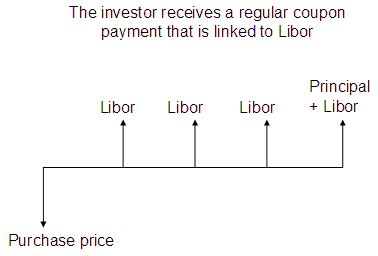
Barbican Consulting Limited
All in Floating Rate Cost of Issuance

Floating rate notes
Floating rate notes (FRNs) are often used to borrow for periods of between 3 and 15 years. FRNs are bonds that pay investors a regular coupon linked to short term interest rates like three or six month Libor. This can suit the investor and issuer alike. No more so than in the financial sector where firms mitigate their interest rate risk by keeping their assets and liabilities on a variable rate basis.

Pricing
In order that the borrower can attract the investor the FRN must provide the investor with sufficient return for the risks that are being taken. Primarily the investor is taking the credit risk of the issuer (will they repay) and liquidity risk (how long will the money be tied up?).
In order to determine the FRNs issuance price and maturity investors turn to banks that have sufficient expertise to judge exactly what investors need in order to be persuaded to buy the bond. This process of understanding both the desire of the issuer to keep the cost of funds down and the investor to get a return that is sufficiently attractive is very important. If the pricing is misjudged the bond issue will be too cheap or too expensive. In either case the interest of the borrower would have been compromised.
Let’s assume our example this hasn’t happened and we just want to know how the issuer can make sense of the cost of borrowing.
A simple example
Suppose the borrower issues a FRN on the following terms:
Principal: $100,000,000
Coupon: Libor
Maturity: 5 years
Issue price: 100% (Par)
Proceeds: $100,000,000
What’s the cost of borrowing? I’m sure you will immediately see it is Libor flat. ($100m comes in, Libor is paid and then $100m is repaid).
Sometimes the FRN can have a fixed margin added to the Libor payment. This could be as small as 5 basis points or much higher, for example 200 basis points. It just depends on what is required in order to sell the FRN to investors. In our example the margin was 200 basis points the all-in-cost to the issuer would be Libor + 200 bp.
A FRN issued at a discount to par
Bonds are frequently issued at small discounts to par value. That’s because bonds normally redeem at par value and discounts create a capital gain whilst premiums create a capital loss on maturity.
The following FRN has been issued at a discount:
Principal: $100,000,000
Coupon: Libor
Maturity: 5 years
Issue price: 99%
Proceeds: $99,000,000
So what is the issuer’s funding cost?
You could say it was Libor flat plus $1m. Why? Because the borrower receives $99m but must redeem the bond at par value ($100m). But it is usual to express the $1m in terms of the equivalent number of basis points that it adds to the interest cost. Let’s continue our example.
This borrower gets $99m but pays interest on $100m. The $1m shortfall is the equivalent of $200,000 per annum for each of the five years. This is the equivalent of 20 basis points on the cost of funding ($200,000 / $100,000,000). You could say the all-in-cost was Libor plus 20 basis points. You would be almost right but you haven’t taken into account the time value of money. Let’s see what difference that makes.
The quarterly cash flow value of $2,500 ($100m x 0.01% x 1/4) is discounted to give the present value. The summation gives the present value of one basis point paid on a quarterly basis for five years.
Principal 100,000,000.00
Rate 3.70%
Years Discount factor 0.01% Discounted
0.00 1.0000
0.25 0.9910 2,500.00 2,477.40
0.50 0.9820 2,500.00 2,455.00
0.75 0.9731 2,500.00 2,432.80
1.00 0.9643 2,500.00 2,410.80
1.25 0.9556 2,500.00 2,389.00
1.50 0.9470 2,500.00 2,367.40
1.75 0.9384 2,500.00 2,346.00
2.00 0.9299 2,500.00 2,324.78
2.25 0.9215 2,500.00 2,303.76
2.50 0.9132 2,500.00 2,282.93
2.75 0.9049 2,500.00 2,262.29
3.00 0.8967 2,500.00 2,241.84
3.25 0.8886 2,500.00 2,221.57
3.50 0.8806 2,500.00 2,201.48
3.75 0.8726 2,500.00 2,181.57
4.00 0.8647 2,500.00 2,161.85
4.25 0.8569 2,500.00 2,142.30
4.50 0.8492 2,500.00 2,122.93
4.75 0.8415 2,500.00 2,103.73
5.00 0.8339 2,500.00 2,084.71
Present value 1 basis point value ===> 45,514.13
How many basis points is $1,000,000 worth?
$1,000,000 / $45,414 = 22 bp
This means that the issuer’s all-in-cost is Libor + 22 basis points. This rate can now be compared with different funding sources in order to determine whether it is sufficiently attractive for the issue to proceed.